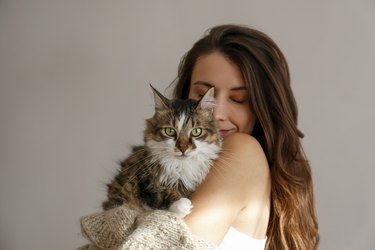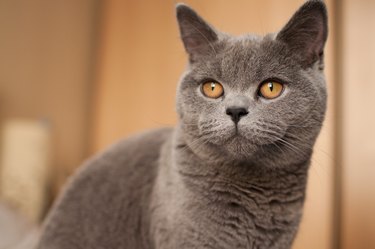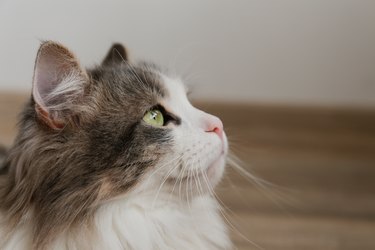
Ragamuffin quick facts
Length: 12 - 18 inches
Weight: Females: 10 to 15 pounds, Males: 15 to 20 pounds or more
Video of the Day
Video of the Day
Lifespan: 13 - 16 years
Coat length: Medium to long
Coloring: All colors and coat patterns except for pointed colors
Grooming needs: High
Friendliness: Breed alone is not an accurate predictor of individual cats' personalities. However, ragamuffin cats are generally regarded as affectionate, friendly, and relaxed.
Ragamuffin cats have beautiful long hair and walnut-shaped eyes that can capture your heart. The cat breed has a loving personality to match and while they enjoy playing, they also love to cuddle like a teddy bear. Before bringing a ragamuffin kitten into your home, consider their personality and care requirements to make sure the breed is a good fit for your home and lifestyle.
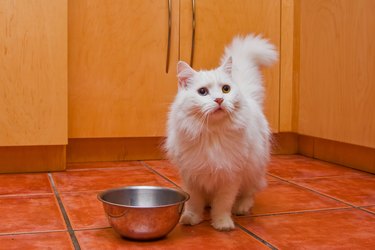
Ragamuffin cat history
The history of the ragamuffin breed begins with the ragdoll cats. Ragdolls were developed in the 1960s by Ann Baker in California. The breed originated from a domestic longhair cat named Josephine who had some kittens with the unique ragdoll temperament and habit of going limp when they are picked up. By continuing to breed these unique and desired characteristics, she developed the ragdoll breed. Many breeders started to breed ragdoll cats and register them with the registry created by Ann Baker.
Eventually, a group of breeders decided to break away from Baker's purebred ragdoll breed registry. They took their ragdoll cats and applied for recognition for the breed from the American Cat Fanciers Association. At that time, the group selected the name ragamuffin for the new breed. The breed is also recognized by the American Association of Cat Enthusiasts and the Cat Fanciers Federation. The Cat Fanciers' Association (CFA) granted the breed championship status in 2011.
The ragamuffin cat breed still shares many characteristics with the ragdoll, including their large size and long coat. There have developed differences as well. While ragdoll cats all have a colorpoint coat pattern and blue eyes, the ragamuffin breed standard allows other coat patterns except pointed colors and most eye colors. Some of the accepted colors and patterns for ragamuffin cats include:
- solid colors including white, black, blue, lilac, and chocolate
- shaded colors include chinchilla, shaded golden, and tortoiseshell shaded
- tabby colors and patterns include classic tabby, mackerel tabby, and patched tabby in a variety of colors including brown, blue, fawn, and lilac
- parti-colored including tortoiseshell, blue cream, lilac cream, and fawn cream
- mink pattern in colors including natural, blue, champagne, platinum, and fawn with aqua eyes
- sepia colors and patterns including sable, champaign, blue sepia, and red sepia with yellow-gold to green eyes
- calico and bicolor pattern in all coat colors
Ragamuffin cat personality
Ragamuffin cats may be the ideal lap cat. They are sweet and affectionate and love nothing more than time cuddling with family members. And as the name implies, they will go limp like a rag when you hold them in your arms.
The cats are calm and patient and enjoy being a part of family activities. While they love to cuddle, they also enjoy playtime. These personality traits make the breed a great choice for families with children and other pets as the ragamuffin will fit right in. The cats can also be trained to walk on a leash, play fetch, and do tricks.
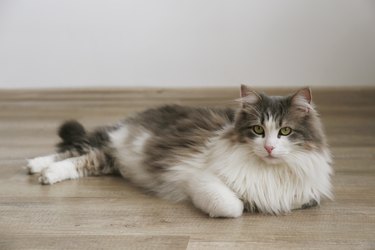
Ragamuffin cat lifespan and health issues
A healthy ragamuffin cat typically has a life expectancy of 13 to 16 years. They are generally quite healthy, but there are some health problems to watch out for with this breed. Two common concerns are:
- polycystic kidney disease (PKD): A genetic health condition that causes cysts in the kidney and can eventually cause kidney failure.
- hypertrophic cardiomyopathy: A type of heart disease that causes a thickening of the heart muscle.
The ragamuffin is a large cat and obesity is a concern as it can cause or worsen other health problems. If your cat is overweight, work with a veterinarian to make adjustments to your cat's diet and exercise programs.
Ragamuffin cat grooming and care
Ragamuffin cats have medium-long to long long fur and a thick undercoat. Brush the cat each day to keep the coat from matting. Make sure to comb the undercoat as well, not just the smooth surface hairs. Work out knots gently before they have the chance to become more serious mats. Matting can be extremely painful for a cat and the fur may need to be shaved completely to remove the mats.
Brush the cat's teeth regularly using toothpaste that is veterinarian-approved for cats. Check their nails each week and trim them as needed.
Feed high-quality cat food in the amount recommended by your veterinarian. Avoid free feeding as many ragamuffin cats have a tendency to become overweight.
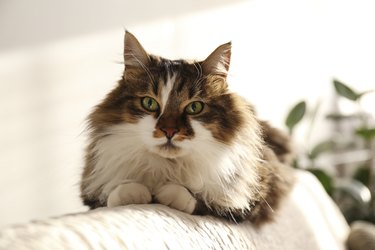
Welcoming a new cat into your home
Before you welcome a new ragamuffin kitten into your home, make sure you cat-proof the home to make sure you have a safe environment for the cat. Set up a room where you can allow the cat to get comfortable with their new environment. Make sure you have all the supplies you need including:
- food and water dishes
- litter box
- cat tree
- scratching post
- toys
Allow the new cat to explore the room at their own pace. While the ragamuffin cat loves to cuddle, avoid the temptation to grab the cat and hold them to be petted. Allow the cat to come to you when they are ready.
Once the new cat starts feeling comfortable, introduce any other pets or children in the home. Talk to your kids to make sure they handle the new cat gently and monitor the interactions between the new ragamuffin cat and other pets to make sure everyone stays safe. Always use positive reinforcement with your cat.
When you are confident that the ragamuffin cat and other pets will get along and the ragamuffin is comfortable, you can open up the door and allow them to explore more of the home. Before you know it, your ragamuffin will make themselves an integral part of the family.
